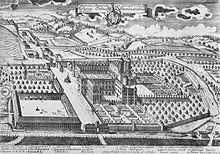Antiphonarium ad usum chori Rothensis
The Antiphonarium ad usum chori Rothensis (colloquially Red Choral handwriting ) is under Abbot Nikolaus Betscher created in 1791 Choral handwriting of Michael Haydn with antiphons by the liturgical year , the Liturgy of the Hours of the canons of the former Premonstratensian Rot an der Rot Abbey in Upper Swabia .
History of the chorale manuscript
The antiphony is a type of music-making in which given musical elements are answered by other voices or instruments. In this case it is the unanimous Gregorian chant of the religious alternating with the organ , integrated into the liturgy and church music of the Premonstratensians.
The lavishly decorated book had its place on the red choir organ , which accompanied the choir singing of the canons . Abbot Nikolaus Betscher and the Red Canon Sigmund Hogl put together the antiphonarium and sent the composition to Michael Haydn on the eve of the secularization in Salzburg . Haydn wrote the organ part for accompaniment as a figured bass part .
In 1803, after the abbey was abolished, it was lost. In 1929 it reappeared in the possession of Karl August Gasser, who was born in Rot an der Rot in 1845. From there it was handed over to the then bishop of the Rottenburg-Stuttgart diocese , Joannes Baptista Sproll , via a pastor from Esslingen am Neckar . Since then, the antiphonarium has been in the possession of the diocese library .
On the occasion of the 200th anniversary of the death of Johann Nepomuk Holzhey , the builder of the Red Organs, pieces from the Antiphonarium were performed again on September 19, 2009 by Franz Raml and the Schola Gregoriana Rothensis . The accompanying lectures to the chorale manual were given by Professor Konstantin Maier and Dr. Gerd Leipold .
Chorals
- O Verena sponsa Christi (hymn for the feast of St. Verena )
- Veni Sponsa
- Dixit Dominus VII. Tone
- Regina Coeli
- Ave Regina caelorum
- Veni Creator
- Pange lingua
- Te Deum
